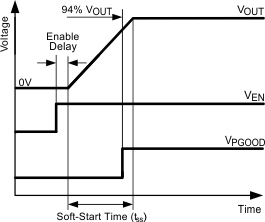SNVS615K January 2010 – February 2018 LM27402
PRODUCTION DATA.
- 1 Features
- 2 Applications
- 3 Description
- 4 Revision History
- 5 Pin Configuration and Functions
- 6 Specifications
-
7 Detailed Description
- 7.1 Overview
- 7.2 Functional Block Diagram
- 7.3
Feature Description
- 7.3.1 Wide Input Voltage Range
- 7.3.2 UVLO
- 7.3.3 Precision Enable
- 7.3.4 Soft-Start and Voltage Tracking
- 7.3.5 Output Voltage Setpoint and Accuracy
- 7.3.6 Voltage-Mode Control
- 7.3.7 Power Good
- 7.3.8 Inductor-DCR-Based Overcurrent Protection
- 7.3.9 Current Sensing
- 7.3.10 Power MOSFET Gate Drivers
- 7.3.11 Pre-Bias Start-up
- 7.4 Device Functional Modes
-
8 Application and Implementation
- 8.1
Application Information
- 8.1.1 Converter Design
- 8.1.2 Inductor Selection (L)
- 8.1.3 Output Capacitor Selection (COUT)
- 8.1.4 Input Capacitor Selection (CIN)
- 8.1.5 Using Precision Enable
- 8.1.6 Setting the Soft-Start Time
- 8.1.7 Tracking
- 8.1.8 Setting the Switching Frequency
- 8.1.9 Setting the Current Limit Threshold
- 8.1.10 Control Loop Compensation
- 8.1.11 MOSFET Gate Drivers
- 8.1.12 Power Loss and Efficiency Calculations
- 8.2 Typical Applications
- 8.1
Application Information
- 9 Power Supply Recommendations
- 10Layout
- 11Device and Documentation Support
- 12Mechanical, Packaging, and Orderable Information
Package Options
Mechanical Data (Package|Pins)
Thermal pad, mechanical data (Package|Pins)
Orderable Information
8.1.6 Setting the Soft-Start Time
Adding a soft-start capacitor reduces inrush currents and provides a monotonic start-up. The soft-start capacitance is calculated by Equation 10:

As shown, the CSS capacitance is set by the desired soft-start time tss, the soft-start current Iss (3 µA) and the nominal feedback (FB) voltage level of 0.6 V. If VVIN and VVDD are above their UVLO voltage levels (2.9 V) and EN is above the precision enable threshold (1.17 V), the soft-start sequence begins. The LM27402 defaults to a minimum start-up time of 1.28 ms when a soft-start capacitor is not connected. In other words, the LM27402 will not start-up faster than 1.28 ms. The soft-start capacitor is discharged when enable is cycled, during UVLO, OTP, or when the LM27402 enters hiccup mode from an overcurrent event.
There is a delay between EN transitioning above 1.17 V and the beginning of the soft-start sequence. The delay allows the LM27402 to initialize its internal circuitry. Once the output has charged to 94% of the nominal output voltage and SS/TRACK has exceeded 564 mV, the PGOOD indicator transitions high as illustrated in Figure 29.
 Figure 29. Soft-Start Timing
Figure 29. Soft-Start Timing